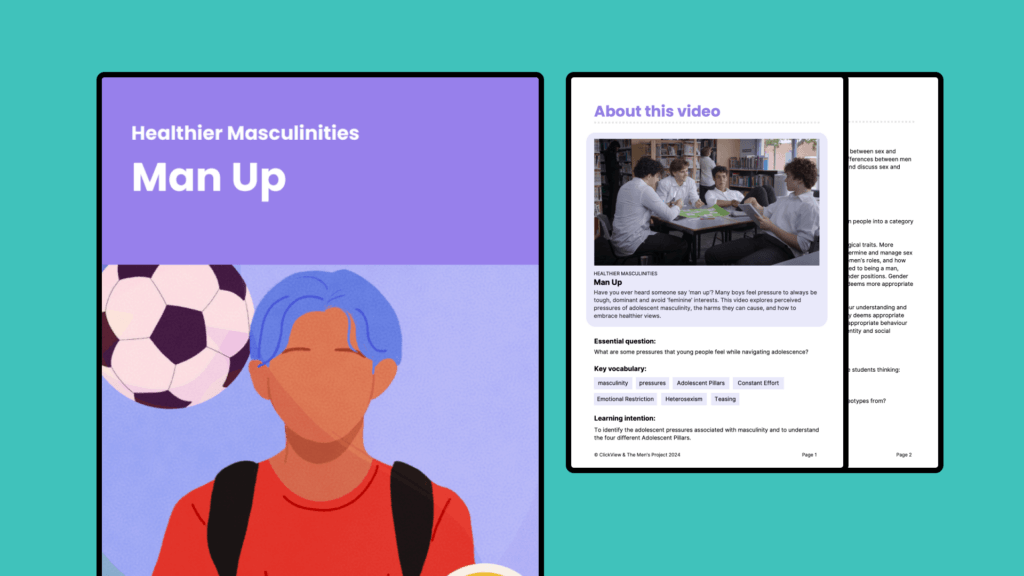4 Tips for discussing toxic masculinity, social media & gender norms in secondary school classrooms
There’s a lot of discussion about the new Netflix series Adolescence. From Prime Minister, Keir Starmer telling the filmmakers that it was “really hard to watch” and welcoming Netflix’s move to make the series available to screen for free in secondary schools, to the online discourse (both positive and negative) about the programmes themes. As a former secondary teacher in both the UK and Australia, I’ve seen a shift in how teenagers interact with one another with the increased use of smartphones and social media. From sexting, exposure to pornography and online bullying, the changes I’ve observed in how teenagers interact with one another have been exacerbated by the lockdowns during Covid-19 pandemic. Teenagers are increasingly engaging with online personalities, and figures of the “manosphere” such as Andrew Tate, and see examples daily of “hegemonic masculinity” exemplified in President Trump and the former Prime Minister of Australia and Advisor to the UK Board of Trade, Tony Abbott.
How might educators address Healthy Masculinity within their classrooms?
It goes without saying that addressing topics that explore issues relevant to the youth of today such as adolescent male health, online radicalisation of youth, masculinity stereotypes in the media, gender norms, male identity and incel culture’s impact on adolescence – which often get lumped together as ‘toxic masculinity’ – isn’t easy. Although it’s likely that PSHE and RSE teachers are leading the charge, it really is something that all educators can address in their daily interactions with students.
Healthier Masculinities 7-part original series
Tip #1: Use the ‘Healthier Masculinities’ video series to highlight the themes
We’ve collaborated with The Men’s Project to develop an original ClickView series complemented by supplementary resources to support teachers as they explore healthy examples of masculinity with their students. We’ve steered clear of using the word tox, and here’s why.
We deliberately avoided using the term ‘toxic masculinity’ in the series for a number of reasons. The Men’s Project has found in its research that the term has a blanket shaming effect, and its use can cause males who strive to be respectful towards their peers, and those with more neutral views, to feel lumped into a category and demonised along with males who are doing harm. In fact, using the term ‘toxic’ in discussions can push males with quite neutral, and even respectful attitudes to adopt more negative ones, the opposite of what we’re trying to achieve.
The title of the series itself, Healthier Masculinities, is an invitation to consider what positive male role models look like, how to express a greater spectrum of human emotion in healthy ways, and how to help young people feel freer from often misguided and unrealistic expectations.
Avoiding the term doesn’t excuse harmful behaviour, or males who prescribe to very negative views and stereotypes, of which there are undoubtedly many. Rather, it aims to address those behaviours and stereotypes with greater nuance and include boys and young men in the conversation, rather than push them away. We certainly haven’t avoided calling out negative behaviour in the series. We’ve presented many examples of what it looks like. We’ve just attempted to help audiences understand the specific reasons why boys and young men are attracted to, or are being led towards, harmful views, and offered some strategies for achieving more positive outcomes.
The data shows that when boys and young men feel heard, and the issues are unpacked in non-judgmental ways, the pathways to treating other people, and themselves with greater respect are easier to navigate.

— Dane Picken,
Producer at ClickView
Although this series is likely to be welcomed by those teaching PSHE and RSE, the videos and supplementary resources, can be used in many other contexts. So, what does it explore? The series explores masculinity, the four pillars of masculinity and examples of positive masculinity in film.

Tip #2: Use Teacher Packs to guide discussions and facilitate conversations
Each video in the 7-part Healthier Masculinities series also has a suite of supplemental resources. These include a Teacher Pack and pre-made video interactives.
Teacher Pack
The Teacher Pack includes:
- Comprehensive notes and strategies to tackle the themes that are discussed in each of the videos,
- Pre, during and after activities to explore what is covered in the video but also the larger themes and ideas that the video discusses,
- Support and extension activities.

Tip #3: Use interactive videos so students can reflect on challenging themes and topics in their own time and space.
To support each of the videos in the series Healthy Masculinities, we’ve created two pre-made interactives per video. The pre-made interactive videos include:
- An interactive to use while you are viewing the video as a class. It includes prompts throughout that will encourage classroom discussion and reflection
- An interactive for students to complete on their own.

Positive examples of masculinities in film

Tip #4 Leverage Films and TV to explore examples of masculinity
It probably won’t surprise you to know that films have the power to foster empathy. (Reddan, Golari and Zaki, 2024). Moreover, they are wonderful tools for developing critical thinking skills such as perspective-taking, challenging assumptions and raising awareness of and exploring real-life issues. So, to help start conversations around healthy masculinities with students and as a springboard to using the resources above, here are three activities we recommend you use.
Hook: An exploration of Fatherhood with Bluey and The Simpsons or The Family Guy
One way to get students thinking about some of the larger issues that the series Healthier Masculinities is by looking at male stereotypes and fatherhood. There are so many representations of fatherhood that we can choose from, but for me, there are a few television programmes that always hit the mark, Bluey, The Simpsons and/or The Family Guy. Each of these shows is likely familiar to young people, and importantly, they use humour as a way to explore complex topics.
Ways to use these programmes to explore masculinity
- Compare characters such as Bandit, Homer Simpson and Peter Griffin using a VENN diagram or a Project Zero Thinking Routine such as Same and Different.
- Explore fatherhood and positive examples of men in episodes from Bluey using a discussion strategy such as concentric circles or speed dating. Here are some Bluey episodes that could be used: Stumpfest, Dad Baby, and Sleepytime.
Both of these activities can lead to larger classroom discussions and activities, or as an entry point to using the videos and resources from the series Healthier Masculinities with your students.
Hook: Gender Norms in the movie Black Panther
I’m not much of a fan of superhero movies, but when I saw Black Panther, I was blown away. It was like nothing I had seen before. Not only does the movie subvert gender norms, but women are seen as warriors and leaders, and men are emotional and compassionate. Use Project Zero Thinking Routines such as Compass Points, The 3 Whys, or Seek to See to get students to think about how the movie subverts gender norms and how they feel about it, before launching into the meatier content in the series Healthier Masculinities.
Hook: Examples of Toxic Masculinity in Film
Although we’ve steered clear of using the term ‘toxic’ in our series, it goes without saying that at some point, the term’ toxic masculinity should be discussed. A simple way to do this is by posing the following question: What do the films Barbie, The Joker, Romeo and Juliet, and The Social Network have in common? (Note: you may need to change some of the titles here, but I’ve included a couple that might not seem to fit together in an obvious way).
I recommend using a Think, Pair, Share approach before a larger classroom discussion. One of the commonalities is that they all have representations of toxic masculinity. Of course, some discussion will need to take place as to what ‘toxic masculinity’ is, and how these films show examples of this. After this discussion has run its course and to anchor students back to positive masculinity, the follow-up question should be: What are examples of positive masculinity in film? We’ve provided a lot of examples on our topic page, but hopefully, the students will be able to come up with their own.
But let’s not stop there, we have other topics at ClickView that could be used to support the teaching of such a topic. Topics that explore Respectful Relationships, Growth Mindset, Resilience, Fake News and Online Safety can all be leveraged to help teachers and their students navigate this challenging topic.
Start the conversation in your school
As educators, we have a unique opportunity to shape how young people understand and express masculinity. The Healthier Masculinities series was designed to support these important conversations—featuring expert-led content, engaging storytelling, and ready-to-use teaching resources.
Whether you’re exploring these topics in PSHE, RSE, or through day-to-day classroom moments, the series provides a flexible, practical way to get started.

Tara Walsh
briefcase iconHead of Education
A qualified teacher and human resources professional, Tara has had an extensive career as a teacher and leader in K-12, and in learning and development.
Other posts
Want more content like this?
Subscribe for blog updates, monthly video releases, trending topics, and exclusive content delivered straight to your inbox.






